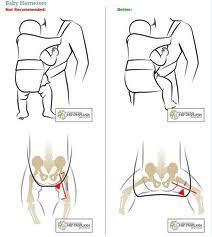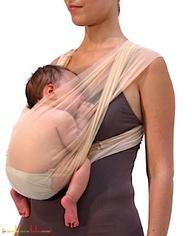I've been asked what this means, and why it's important enough to influence my choice of a carrier, so I thought I would share some of the important "rules" of baby wearing, and how to safely wear your baby.
As I mentioned before, I'm pretty new to baby wearing, but everything I've read stresses these points as important. That's not to say that if you use a high street carrier every once in a while that its anything awful, or that if your baby faces forward occasionally their hips will fall to pieces! At the end of the day ANY baby wearing is better than none! But if you plan to baby wear more than occasionally, it's important to know how to do so safely, and what you should look out for in a carrier.

The T.I.C.K.S. Rules:
These tell you how things should look once your baby is in the carrier.
T- tight. Your sling, wrap or carrier should hold your baby tightly against your chest or back. This will be most comfortable for you both, and won't allow baby to slump down. There shouldn't be a gap between you and your baby's chest at any time.
I - in view at all times. You need to be able to see your baby without having to move any fabric, especially in a sling. You should be able to see your baby's face just by glancing down.
C - close enough to kiss. You should be able to tilt your head down and kiss your baby. This means your baby is being carried high enough. I love testing this out by kissing Izzy all over, and even nibbling her ears at times!
K - keep the chin off the chest. If the baby's chin is on their chest, their airway can be restricted. You should be ale to fit a finger under baby's chin, and their nose should be parallel to the floor to ensure they can breathe easily.
S - supported back. Your baby's back needs to be well supported to stop the, slumping, which can restrict their airway and is bad for their back. This ties in with keeping them tight. If your baby is tightly against your chest or back (no big gap, their chest should be touching yours at all times in an upright carry) you should be able to push their back, and they shouldn't move forward.
Baby's leg position
I wrote in my last post that I wanted a carrier to keep my baby in a froggy, M leg position. I should have also said that I wanted it to carry them knee to knee. All of this is to ensure that the baby is kept in a favourable hip position. Traditional high street carriers support baby under their crotch (leading to the derogatory term "crotch danglers" by many baby wearing aficionados), and allow their legs to dangle down freely. This means their hips are left in a position which can contribute to hip dysplasia. However, carriers such as the Boba, Ergo and many other brands (including slings, wraps and stretchies) support the baby from the crook of one knee, under the bum, and to the crook of the other knee. This actually holds their knees slightly higher than their bottom, in an M shape. This position is much better for babies hips, holding them in a more natural position.
 Similarly, many carriers/wraps will advise carrying baby with their "legs in" in a froggy position while they are newborn. There is some controversy over this at the minute, but the premise is the same - keeping their knees higher than their legs in a babies natural hip position. (Try it out with a newborn - hold them against your chest and they will almost certainly curl their knees up towards their chest). The Boba 3G instructions advised legs in, so I followed this advice, making sure Izzy was always in a froggy, M position. The picture below gives a good idea of how a baby's legs should look in a correct carry (however this baby wouldn't be close enough to kiss!)
Similarly, many carriers/wraps will advise carrying baby with their "legs in" in a froggy position while they are newborn. There is some controversy over this at the minute, but the premise is the same - keeping their knees higher than their legs in a babies natural hip position. (Try it out with a newborn - hold them against your chest and they will almost certainly curl their knees up towards their chest). The Boba 3G instructions advised legs in, so I followed this advice, making sure Izzy was always in a froggy, M position. The picture below gives a good idea of how a baby's legs should look in a correct carry (however this baby wouldn't be close enough to kiss!)
Never facing outThe two points outlined above link into why it's not a great idea to face your baby outwards. Firstly, if they face outwards, they aren't being held tightly to your body, as their natural instinct is to curl up forwards and therefore away from your body. This isn't great for your back, as it throws their weight forward, and puts more strain on your back.
Secondly, if you wear baby facing outwards, it's unlikely that their legs will be supported knee to knee.
If you are planning on baby wearing frequently, look for a wrap, sling or carrier which will allow you to carry baby closely, and supported in the M position from knee to knee. Again, any baby wearing is better than none, so if you do wear your little one in a high street carrier (and let's face it, they are so readily available that many people do!) or forward facing occasionally I won't be calling social services anytime soon!
If you're interested in baby wearing on a more regular basis, check out some of the links below to brands of carriers, and to information on the benefits of babywearing and how to babywear safely.
Ergo Baby
Monkey Mei Tai
Rose and Rebellion
Moby WrapBaby HawkWrap Your Baby
School of Babywearing
Babywearing UK
